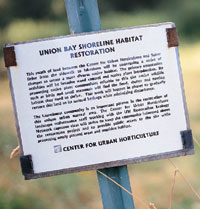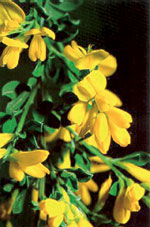
Ironically, Reichard got her start in the very trade that has done more to bring invasive species into the country than any other. In 1988, while working on her master's thesis, she traveled on a seed collecting trip to Chile for the Washington Arboretum. "When I got back, I started to wonder whether any of these seeds could become invasive. I was shocked that I found virtually nothing on how to predict if a plant had the potential to invade," she says. Her thesis included one section on the invasive potential of her Chilean seeds. Since then she has expanded her work to create a litmus test for any introduced plant.
"The best way to prevent a plant from becoming an invader is to prevent it from ever entering a country," she emphasizes. She found that the single best predictor of successful invasion was a previous invasion by that species somewhere else in the world. Other factors that indicated high potential included similar climate and latitude, high seed production, and long flowering and fruiting periods. The model she helped develop correctly classified 86 percent of past species that invaded but it does not answer the single biggest question: why do some plants become botanical cancer, reproducing uncontrollably and damaging their host environment.

Invasive plants such as the Himalayan blackberry have caused problems in the Union Bay Natural Area for years. Photo by Jon Mamor.
Ecologists have offered several hypotheses to answer this question. One is analogous to a teenager going off to college and getting in trouble because the calming influence of her family is now gone. With plants, the theory is that invasives do well away from home because they no longer have predators or pathogens keeping them in check.
Another theory focuses on an invader's ability to hybridize. Researchers recently discovered that the most invasive forms of tamarisk or salt cedar, considered to be the second worst offender in the country after purple loosestrife, were hybrids of two species that did not have overlapping ranges in their native environments. Plant expert Arthur Lee Jacobson believes that one such example in Seattle is the hybrid Japanese knotweed (Polygonum x bohemicum), a combination of Japanese knotweed (P. cuspidatum) and giant knotweed (P. sachalinense), that invades more successfully than either parent.
In the Pacific Northwest, invaders are aided by the mild climate. As we all know, plants thrive in the temperate, rain-soaked environment. They don't have to adapt to freezing temperatures and rarely have to survive a drought. If an invader gets established during typical weather conditions, it may be able to survive the rare extremes. On a climatic plus side, many gardeners know that our dry summers can cause problems and do keep some plants, particularly woody deciduous ones, from getting a seed-hold.

Scotch Broom - One of the 10 Worst Invaders in the Pacific Northwest. Photo courtesy the Nature Conservancy.
"I don't think there is a single answer to the question of why," says Reichard. Around Puget Sound, she and other Center for Urban Horticulture staff and students are trying to address this question by focusing on some of the area's infamous invaders, such as Scotch broom and herb Robert. Two factors stand out: high tolerance to stress and high reproductivity.
Scotch broom, for example, germinates best in dry sandy soils in full sunlight, such as roadways, where it often forms extensive stands. It can tolerate soils with a wide range of pH, sprouting on dunes, in heathlands and acidic grasslands. In addition, plants can fix nitrogen and endure drought, plus the seeds remain viable for up to 80 years. Although many people appreciate the brilliant yellow spring flowers, one writer considered it a poster child for the problems that invasives cause. "It is very aggressive, spreads rapidly, growing so dense that it is often impenetrable. It prevents reforestation, creates a high fire hazard, renders range land worthless and greatly increases the cost of maintenance of roads, ditches, canals, power and telephone lines," says Reichard.
Go To: Page 1 | Page 2 | Page 3
Sidebar: The 10 Worst Invaders in the Pacifc Northwest
- Return to September 2003 Table of Contents